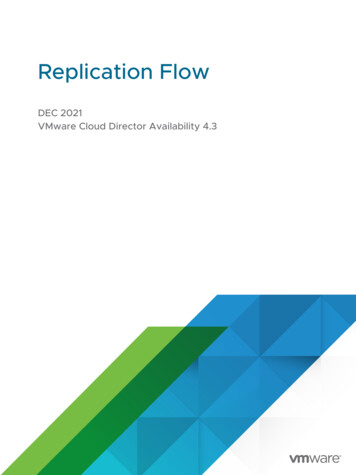
Transcription
Collaboratingin the cloudLeaders in today’s collaborative revolutionreport significant benefitsfrom a cloud-based approachin association with:
ContentsIntroduction: a superior model for collaboration.2The collaborative revolution.3Leaders vs. laggards. 4The end of the faceless employee. 6Other benefits of cloud collaboration.7Examples of cloud collaboration. 8Enhancing how government collaborates with citizens, business and other agencies.10Aiding business understanding—and streamlining the IT footprint.14Conclusion.15About this research.16
Introduction: a superiormodel for collaborationThe ability to collaborate—across functional boundaries, time zones or even beyondorganizational borders—is becoming an ever more critical determinant of success.A good example comes from Colin Miles, head of technical services at Virgin Media. Owing to an array of newtools ranging from video conferencing and document sharing to an in-house, business-oriented social media styleplatform, “we’re getting a lot better at problem-solving—at innovation.” As Miles continues, “virtual communities”allow workers “to see where the challenges are” and allcan “comment at appropriate places.” This drives performance and innovation, says Miles, because “there’s usuallysomeone who’ll have a great idea, and the group can see itin context and act on it that much faster.”But not all methods of collaboration are created equal.When it comes to the strategy and practice of collaboration,nothing can compete with next-generation cloud-deliveredtools and processes.Business executives are beginning to understand the profound nature of this new range of competitive capabilities aswell as becoming more involved in the underlying technology discussions and choices. The following report relies ona survey conducted in October 2012 along with practitionerand consultant interviews. Together they provide a briefingon the degrees to which leading companies are obtaininggreater business effectiveness and value through leadingedge, cloud-driven collaboration.2 CISCO Collaborating in the cloud
The collaborativerevolutionA collaborative revolution has been brewing for well over a decade. It began with surging trafficon the Internet and the overwhelming embrace of message boards, wikis, newsfeeds and emailbut has since expanded to include even more collaboration-focused enablers such as mobile andbroadband, as well as applications such as business-oriented social media and video-conferencing. Today the revolution is reaching fever pitch, as a comparatively new crop of cloud-delivered,collaboration-focused strategies and applications is achieving broader adoption and deliveringremarkable results.Companies today are taking more steps to enable an evermore intimate degree of collaboration between internal groups as far-ranging as finance, R&D, supply chain,production, marketing, logistics and IT. Moreover, themost advanced among these are now pursuing competitive advantage beyond enterprise borders, seeking closercollaboration with customers, suppliers and other external groups.Within this epoch, cloud is surfacing as the medium mostcapable of successfully managing the revolution: quickly,efficiently, and in ways that can manifest dramatic benefits.Consider the ways cloud-based collaboration can: A ccelerate business results. Business initiatives areimplemented faster when the business is infused withcloud-based collaborative agility. So much so that nearlytwo out of three executives, 64%, say that cloud-basedcollaboration tools accelerate business results—a figurethat rises to 82% among so-called “leaders” (see below:“Leaders vs. Laggards”). R evolutionize collaboration across time zonesand functional boundaries. Over half—55%—saythat cloud-based solutions are no mere evolution butrather represent a true revolution in collaborative effectiveness. This figure rises to 87% among “leaders.” Enable more-efficient business processes. Fiftyeight percent of total respondents—and 90% of“leaders”—say that cloud-based collaboration has thepotential to improve virtually any set of processes.Sometimes the improvements are emphatic, such as incases where through collaboration, greater understanding is achieved and a process is refined. In other cases,the benefit is more indirect, such as where efficiencyaccrues from a more connected, and therefore moreclosely aligned, cooperative and motivated workforce. G enerate profound—or even disruptive—innovation. Fifty-nine percent of executives—93% of“leaders”—believe cloud-based collaboration stimulates innovation. Think of enhanced collaboration as ameans of harnessing an ever wider range of functionaland geographic resources. Thanks to cloud delivery,collaborative tools are now more ubiquitous. So morepure innovators are now more connected to others whomay be more process-oriented, and so on. As moreconnections are established and nurtured, as greaterunderstanding is achieved, better ideas germinate, withgreater chances of reaching those in the best position tomake things happen.All manner of companies are in fact using cloud-basedcollaborative tools to transcend not only geographies butalso functional specializations. Interviewees and supporting statistics show that this is one of the key driversbehind the cloud’s ability to accelerate business results.Copyright 2013 Forbes Insights 3
Leaders vs. laggardsA key finding of the survey is that greater experience with cloud-based collaboration tools andstrategies can lead to a significantly more positive view of their value.Survey participants were asked to consider a range of collaboration-focused business imperatives. The full list includes: Incorporate video into meetings Enable meetings with remote participantsand virtual teams Create internal communities and team workspaces Create flexible work areas/office space Collaborate with external organizations Consolidate communications infrastructure Extend telephony with video for visual communicationand conferencing Access collaboration tools within business applications Enable mobile workers with access to collaborationcapabilities “as if in the office” Enable remote workers with access to collaborationcapabilities “as if in the office” Enable any device (“bring your own device” or BYOD) Locate and access remote experts in real time Enable desktop virtualization (software resides on aremote server rather than the local device) Deliver large-scale visual communicationsand online training Provide multichannel customer service Monitor social mediaRespondents were asked to note in which of the aboveareas they were making extensive use of cloud-based toolsand applications. Now the sample could be split into fivecategories of cloud-collaboration adoption based on thenumber of collaborative business imperatives being substantially enabled by the cloud. The categories include: L eaders Extensive use of cloud tools within 10 or moreof the above imperatives (14%) Followers Extensive use within 6-9 imperatives (19%) Early majority Extensive use within 3-5 imperatives (35%) Late majority Extensive use within 1-2 imperatives (21%) Laggards No pursuit of the above objectivesor “not certain” (11%)Thus grouped, further analysis shows that generally, thegreater the experience with cloud-based collaboration, thegreater the perceived, associated value. Specifically, surveyparticipants were asked about the value of cloud-basedcollaboration solutions: do they accelerate business benefits,provide competitive advantage or stimulate innovation? Innearly all instances, leaders are significantly more likely thanlaggards to identify or recognize greater value. Moreover,when plotted from laggard to leader, this relationshipin nearly all instances forms a nearly straight, upwardlysloping line. In other words, the more cloud collaboration tools in use, the greater the business impact. (Theexamples in Figure 1 are typical of the results throughoutthe survey.)Terminology borrows from technology adoption lifecycle models developed by Messrs Bohlen, Beal, Rogers, Gross and Ryan.4 CISCO Collaborating in the cloud
Figure 1. Experience with cloud-based collaboration correlates with perceived valueGenerates profound or disruptive innovation23%41%63%70%93%Enables more-efficient business processes25%32%57%83%90%Accelerates business results31%48%68%78%82%Provides competitive advantage30%57%66%77%78%Worth noting, the size of company has no consistentbearing on the degree of adoption. This means smallercompanies are just as likely to be leaders as are largercompanies. In other words, companies of all sizes are ableto obtain the advantages of cloud-based collaboration.LaggardLate majorityEarly majorityFast followerLeader% Numbers who agree orstrongly agree that cloudbased collaborative toolsconfer the expressed benefitsCopyright 2013 Forbes Insights 5
The end of the faceless employeeQ&A: Colin Miles, Head of Technical Services, Virgin MediaVirgin Media is the first provider of all four broadband, TV, mobile phone and home phone services in the UK.Why are you investing in advanced collaboration tools?Even though we’re UK-centric, our operations are spread out over literally hundreds of sites. So we’ve got a very mobile workforce that spendsa lot of time traveling, away from any fixed office.Another key issue for us is that we were managing some very old technologies. We had fragmented document depositories. We were heavilyreliant on email. And we had—in this day and age—faceless calls.Why are faceless calls an issue?What we’ve learned is that when it’s just a telephone, the level of engagement is somewhat lacking. And if you had to share contents—documents of any kind or if there’s going to be co-creation—you almost hadto travel. In fact, prior to our teleconferencing capability, the feeling wasthat any meeting of any importance had to be face to face.What is the problem with email?There were simply too many of them! As many of our teams work together, there was a tendency to include everyone on every email, just incase they needed to know. We actually found that the longer the tenureof employee, the higher the amount of daily emails they received, asthey were utilized as a source of company information as opposed tocommunication being for them.And email’s linear. They come in all day long, and you work your list frombottom to top or top to bottom. There’s very little prioritization: something vital can sit in your in-box while you deal with any number of other,less time-critical issues simply because they arrived first.What’s the answer?We’ve adopted a suite of collaborative tools. Document management,video conferencing, IMs.What’s the impact so far?It’s genuinely improving the quality of interaction. People are able tohave the conversations they need with the people they need to havethem with and are getting more out of it. And that’s not always a literalconversation. It could be that they go on our business-oriented formof social media. Users can update their profiles so others know theirexpertise. And they post information that’s relevant to the business andtag things so that others can search for the information they need, findit, and go on about their business.Are you measuring the benefits?Much of this is very difficult to gauge. But one thing we do know, it’ssaving our people a lot of time. We estimate that with all the reductions6 CISCO Collaborating in the cloudin travel, the reduced need to comb through email, the improved abilityto find the information that’s needed when needed—all told, it’s savingthe typical employee about 10 hours a week.And we don’t view that as 10 more hours for the company, but ratheras a contribution to a healthier work-life balance. Our people are not onthe road or working late as often, they get to see more of their familiesand friends, and they’re less stressed on the job. They also have moretime to do their job as well as to think about ways to improve things andinnovate. It’s intangible, but the benefits are very real.What have you been learning?One thing you can’t underestimate is the change management, particularly in areas like the use of [business-oriented] social media. There webrought in an outside consultant to help us with the cultural aspects.People weren’t used to being so open, to sharing. They needed tobe led to understand the art of the possible—what can be done in avirtual community.And one of the things we quickly learned was just how much duplicationof effort goes on in a typical business. A project will be running and allof sudden you have two or three teams running around trying to do thesame things when someone else had already gotten it done. With bettercollaboration and communication tools, and with everyone working toproperly tag what they’re doing, there’s a lot less wasted effort.The other thing we’re seeing is that we’re getting a lot better at innovation—at problem solving. When you are running communities, andeveryone can see where the challenges are and can comment at appropriate places, there’s usually someone who’ll have a great idea, and thegroup can see it in context and act on it that much faster. I wouldn’t saywe’ve seen anything dramatic yet—but the pace of problem identification and solution is definitely faster.Is there anything you’re surprised we didn’t ask?One thing that’s really come to light for me is the value of building oneon-one connections within a massive organization. Your work can beconnected to people across the country or in the same building and yetyou’ve never met. But when you’re on [video] call, there’s a more humanconnection. Suddenly that’s not just a name but it’s a person you canrelate to. You get to know what makes them tick. You feel empathy fromtheir expressions and body language. A connection builds, and you’reno longer just listening to that person because it’s your job but reallywant to live up to your commitment to that person. That’s a businessbenefit that can’t be measured, but when you multiply it by the numberof new connections, it’s got to be a powerful driver of performance.
Other benefitsof cloud collaborationThe reality is that the greater the familiarity with cloud-based collaboration tools, the greater therecognition of their value. Again, these results are remarkably consistent throughout the report,as further illustrated by the following additional benefits of cloud-based collaboration.Figure 2. Cloud-based collaborationEnables flexible work environments28%66%94%Enables greater collaboration with customers39%67%91%Enables new products/services31%74%90%Supports business scalability39%69%89%Enables mobile workforce productivity38%76%89%Reduces operating costs27%64%86%Enables greater collaboration with suppliers/partners28%62%84%LaggardEarly majorityLeader% Those who agree orstrongly agree that cloudcollaboration tools conferthe specified advantageCopyright 2013 Forbes Insights 7
Examples of cloudcollaborationAdvancements in collaboration begin first with the commitment to the strategy: collaborationcreates value. From there, an organization needs to focus on change management: specifyingobjectives, incentives and culture.John Jackson, VP for global infrastructure at D M Group, amaker and distributor of home, auto and commercial speakers and sound systems, strongly agrees. “One of the thingswe frequently discuss is how we can improve the qualityof communications. We have a large presence in Japan, andthat takes us to where we have people who aren’t fluent inEnglish. So achieving real understanding can be a challenge.But now, we have engineers or marketing staff conductingpresentations via telepresence. So you have written presentations and there’s whiteboarding and people are able to showthe actual designs or blueprints and get a strong reaction, andit’s just amazing what that can do to improve collaborationacross time zones and languages.”Examples of how cloud technology is being harnessed to propel strategies and achieve objectives include: Creating flexible work/office spaces Over a third oforganizations, 39%, say they are making extensive useof cloud-based applications to enable greater workforceflexibility. Cloud-delivered tools including video, voice,email, IM, data management as well as access to relatedcore business processes can help workers share and accessinformation and work on an anywhere, anyplace, anytimebasis. The most advanced instances are also device agnostic, enabling access to collaboration tools from PCs, laptopsor smartphones (a so-called bring your own device—BYOD—approach). Overall, these companies are enablingconsiderably improved collaboration across time zones andfunctions as well as improving the effectiveness of remotelybased or highly mobile team members. Notice, however,that the figure more than doubles to 86% among leaders.Throughout the analysis, leaders are far more aggressivein the pursuit of collaborative strategies (see Figure 3). Incorporating video into meetings The telephone wasonce the primary means of remote yet instantaneous collaboration. Today 42% of companies at large—but 89%of “leaders”—are making use of voice augmented withstreaming video delivered via cloud. The advantages are8 CISCO Collaborating in the cloudmany—such as the improved quality of communicationachieved through the ability to gauge facial reactions andmannerisms. But users can also, for example, more readilyview a product, conduct healthcare-related evaluations, ortroubleshoot a complex piece of machinery. Enabling meetings with remote participants andvirtual teams Nearly half (48%) of organizations todayare making extensive use of cloud-delivered collaborative tools to enable “live” multimedia interaction. Butthe figure rises to 90% among “leaders” and 68% among“followers.” By using a consistent interface group-wide,businesses and other entities are able to simultaneouslyview presentations, share documents and see other participants. Combining visual with voice greatly improvesthe quality of interaction. Moreover, the ability to recordevents enables others to review proceedings when bothneeded and convenient, perhaps in their own time zones orwhen other—for their individual purposes, higher-priorityactivities or events—conclude. Creating internal communities and team workspaces Thirty-nine percent of survey participants say theyare making significant strides toward the most advancedstate: a truly digitized, collaborative workspace in theform of internal communities and team workspaces. Thefigure rises to 72% among “leaders” for whom breakingdown functional as well as time zone barriers is a priority.Often at the heart of such initiatives is a sort of purpose-built social media-style platform—but decidedlymore attuned to business objectives. Team members canupdate their personal profiles to include current skills,task-related interests and needs. Participants can post documents, videos, emails, relevant or useful links and similarobjects of potential interest to others in the organization.Tags—search terms based on keywords correlating to keyorganizational executives—are added to these objects inorder to help others find who and what they need.
Team members can also view one another’s calendars,exchange emails and IMs, or initiate calls. Advanced systems can also enable assignment and review of work basedon hierarchical priorities. Such digital workspaces are oftenmerely primordial. But at their core, advanced platformsrequire standardization in key areas such as communication, conferencing, data retrieval and storage, security andsearch capabilities. All of these features are most readilyachieved and maintained in a cloud environment.Figure 3. Capabilities enabled through cloud collaborationLeaders are using cloud technologies to achieve a broader array of business imperatives.TotalLaggardLate majorityEarly majorityFast followerLeader48%0%26%48%68%90%Incorporate video intomeetings42%0%17%38%65%89%Enable remote workerswith access to collaborationcapabilities “as if in the office”32%0%6%22%58%89%Create flexible work areas/office space39%0%17%36%56%86%Create internal communitiesand team workspaces39%0%17%37%58%82%Collaborate with externalorganizations33%0%15%31%53%69%Locate and access remoteexperts in real time21%0%3%13%36%65%Enable any device (“bringyour own device” or BYOD)24%0%9%20%34%63%Enable meetings with remoteparticipants’ and virtual teamsCopyright 2013 Forbes Insights 9
Enhancing how governmentcollaborates with citizens, businessand other agenciesQ&A: David Wilde, CIO, The Essex County CouncilEssex County Council is a UK government enterprise with 48,000 far-flung employees and an operating budget of 3 billion.Why is collaboration important to you?There are so many reasons. One is, we have 40,000 publicemployees, teachers, police, maintenance and the like, spreadout over a very rural community. But perhaps the biggest reason, I see cloud as the means to enable us to join up publicservice delivery in a way that just wasn’t achievable before.How so?That’s taking place on a number of levels. We have the technology, the tools to allow people to share information andideas electronically. Next, the second level is collaborationwith the population and the business community to betterinform decision making.Then there’s social networking. One tool we like isTwitter, which we’re using to, for example, alert peopleabout traffic problems—we have over 20,000 followersfor that. Then there’s LinkedIn, which is great for building relationships with business. We can, for example, buildcommunities, like around telecoms, where we can shareideas and opportunities for building or locating a business. And we also use Facebook, which is a great wayto connect with hard-to-reach, because we’re so rural,people being supported by our social care teams.A teenager who’s run away, for example, is very willing tocommunicate via Facebook.What steps are you taking to manage social media risks?We have strong information governance policies in place. Wetalk with people about what to share, what not to share. Andbefore you can post, you have to take a test to show you knowthe rules. And of course, we monitor from there.What about collaboration-specific cloud technologies?So far, that’s mainly internal or interagency. We’re now getting into collaboration on shared services with other agencieslike the National Health, the police and the welfare department. We’re sharing more information to improve services,cut fraud and reduce crime. And we also use documentrepositories where people can work together in a secure environment and there are audit trails of revisions.10 CISCO Collaborating in the cloudAnd we’ve also just rolled out video conferencing to 9,000people. That’s great for one-on-one conversations, where itreally improves understanding. And then there’s other communication tools like instant messaging, which is really reducing the number of emails—and that’s a great thing.Why cloud?It’s just that relative to the traditional IT model, cloud is inso many ways a superior model. For one, it’s more flexible.I have this employee, I know I need fit-for-purpose IT, and ineach case I know exactly what is needed and what that costs.I can have it turned on today, and I can scale it up or downas needed, and I don’t need to do a lot of work on our endgetting it done.I also love that we don’t need a huge footprint. IT is a specialty, but it’s not somewhere where we necessarily want to specialize. We have a rule where if you want to add something,you have to view the cloud first. There has to be a reason todo it in-house. And please don’t bring up security, because asfar as we’re concerned, your data and processes are just assecure in the cloud, if not more so. Overall, cloud just lets youmanage for high performance in an era of diminishing budget.Is there anything you’re surprised we didn’t ask?Video—that’s proving to be a very valuable tool. We just did arollout of a new payroll system and, rather than have to makea hundred presentations, we just posted some how-to videoson the website and we were done. That’s something wherethere’s a lot of potential to improve information sharing.And something else we’re doing, we’re looking for ideas touse information in new ways. We’re saying to the public and tobusinesses, “Here’s the data that we have—now what wouldyou like us to do with it? Is there anything else you want?” Andpart of what we believe will happen is that others will havesome great ideas or will do some innovative things with ourdata which will benefit others.
The cloud: a businessdiscussion and priorityIt is vital to recognize that none of this is a solely IT ornon-IT discussion. By embracing cloud-based collaboration, organizations can achieve breakthrough performance.But achieving optimum results requires active and concerted involvement from both business units and their ITteams. In short, this is not an IT discussion—it is a broaderbusiness discussion.In fact, 49% of survey participants say that business leaders—non-IT executives—are becoming moreinvolved in selection, implementation and managementprocesses relating to their cloud-based collaboration tools.Meanwhile, the figure expands to 75% among “leaders”and 60% among “followers.”Worth noting is that the more involved a companybecomes in cloud-based collaboration, the broader thesphere of influence of non-IT executives. The number ofinstances where survey respondents say any given executive exudes influence in such decisions grows significantlyamong leaders. This is true for both C-suite and line executives. However, the differences are especially pronouncedfor the latter category. For example, only 39% of participants overall and 31% of laggards say a head of sales hasFigure 4. Who plays a role in influencingcloud collaboration decisions?influence over cloud collaboration decision making. Butthe figure increases to 58% among leaders (and expandssimilarly for all manner of department heads).As D M Group’s Jackson explains, “We don’t want tomake large investments in technologies that go unused.” Thebest way forward is “to go around educating the businessleaders on the functionality and value of these tools and thenget buy-in.” In this way, says Jackson, “we get the greatestreturn on our investments, and the business appreciates thevalue in our solutions.”In addition, when it comes to naming the ultimatedecision making in cloud collaboration, among leaders,that role is significantly more likely to fall to the CEO.In short, the more sophisticated a company becomes inits collaboration strategy, the more likely it is that nonIT executives will be playing a more involved if notcritical role.Figure 5. Who is the ultimate decision maker?LaggardCEO41%CIO25%CTO13%CFO3%VP g34%23%54%CTO14%CFO50%46%53%CFO4%Customer service37%31%53%VP 39%VP 4%CIO31%16%39%VP IT9%LeaderTotalCopyright 2013 Forbes Insights 11
The road aheadAs for where survey participants will be focusing additional strategic investment to improve collaboration,priorities, in order of frequency of inclusion among “topthree” include: Customers (65%) Internal teams (53%) Suppliers (38%) Channel partners (22%)A good example of outwardly focused collaborationcomes from the Essex County Council. As Wilde explains,collaboration solutions for his organization have thus farbeen internally focused. But going forward, “we’re nowgetting into collaboration on shared services with otheragencies like the National Health, the police and the welfare department.” In expanding collaboration beyondenterprise boundaries, “we’re able to share more information to, for example, improve services, cut fraud andreduce crime.”Viewing the full spectrum of “go-forward” strategies from laggards to leaders presents a revealing picture.On internal investments, the gap between leaders and laggards is closer. This is likely because leaders have alreadymade great strides and no longer need to focus their future67%investment internally. Leaders, the data reveals, appearnow to be focusing more intently at opportunities to collaborate externally, such as with customers, suppliers andchannel partners.Today’s laggards, on the other hand, in their efforts tocatch up are viewing opportunities with customers andinternal teams in nearly equal light. Meanwhile, in somecases (such as with internal teams) laggards plan to ramp uptheir focus more aggressively than the late or early majorities. In other words, those slow to react may be bypassed.It should come as no surprise that once a company seesthe value of enhanced internal collaboration, it turns itsgaze outwar
2 CISCO COLLAbOrATIng In ThE CLOud A good example comes from Colin Miles, head of tech-nical services at Virgin Media. Owing to an array of new tools ranging from video conferencing and document shar - ing to an in-house, business-oriented social media style platform, "we're getting a lot better at problem-solving— at innovation."










